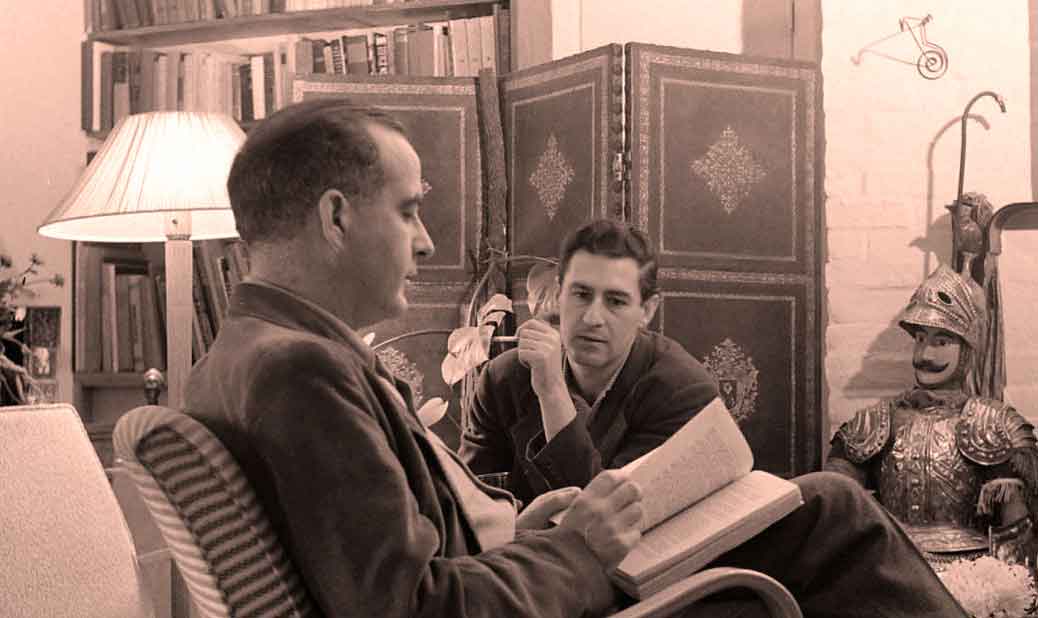
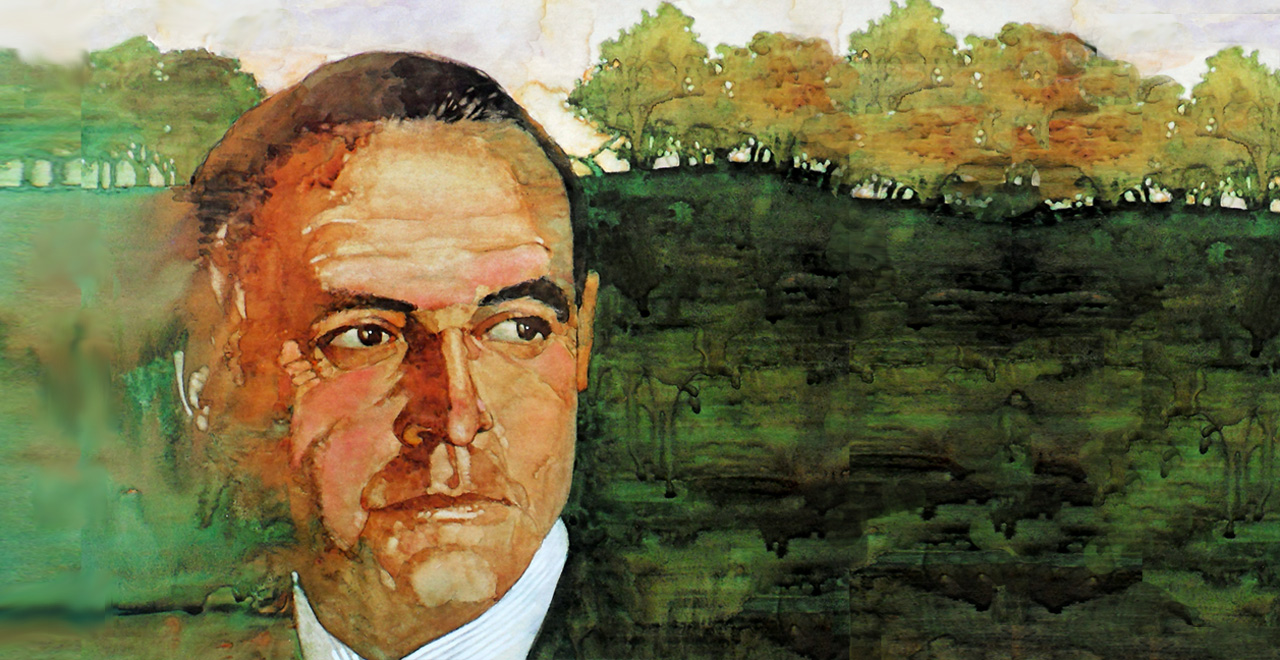
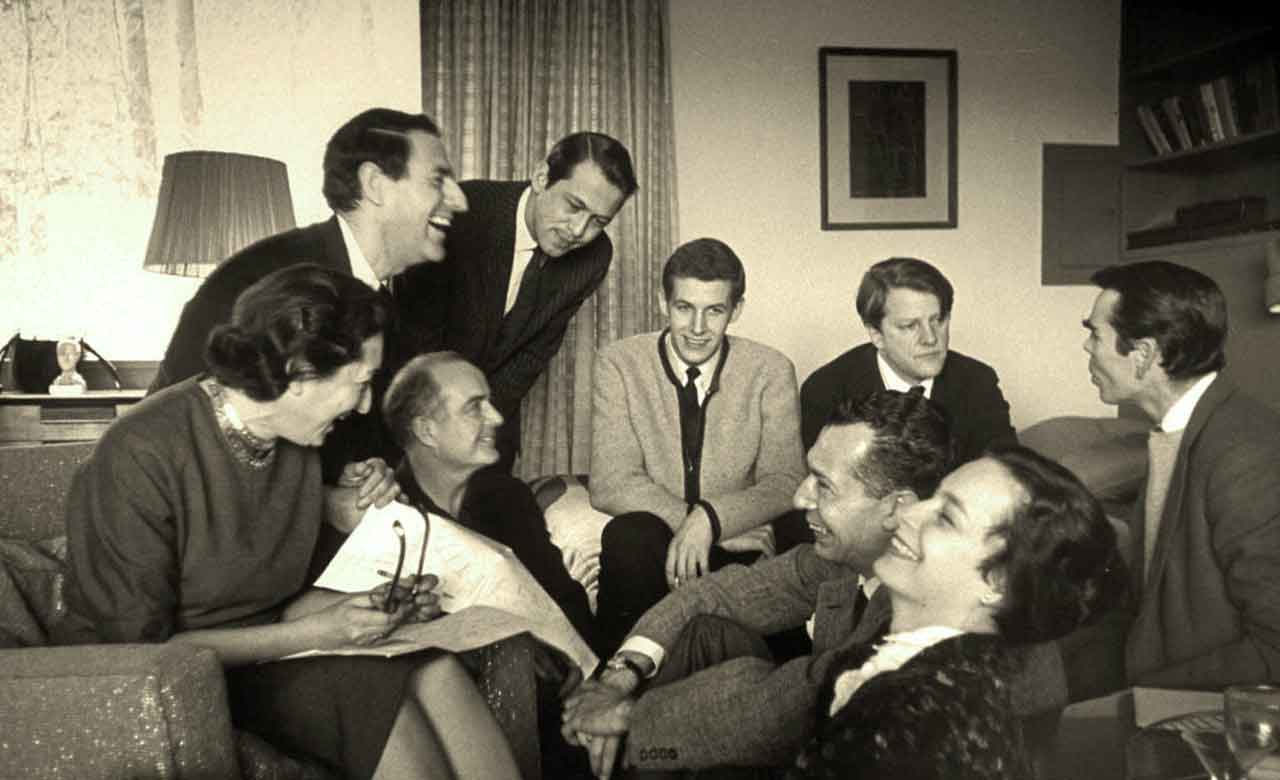
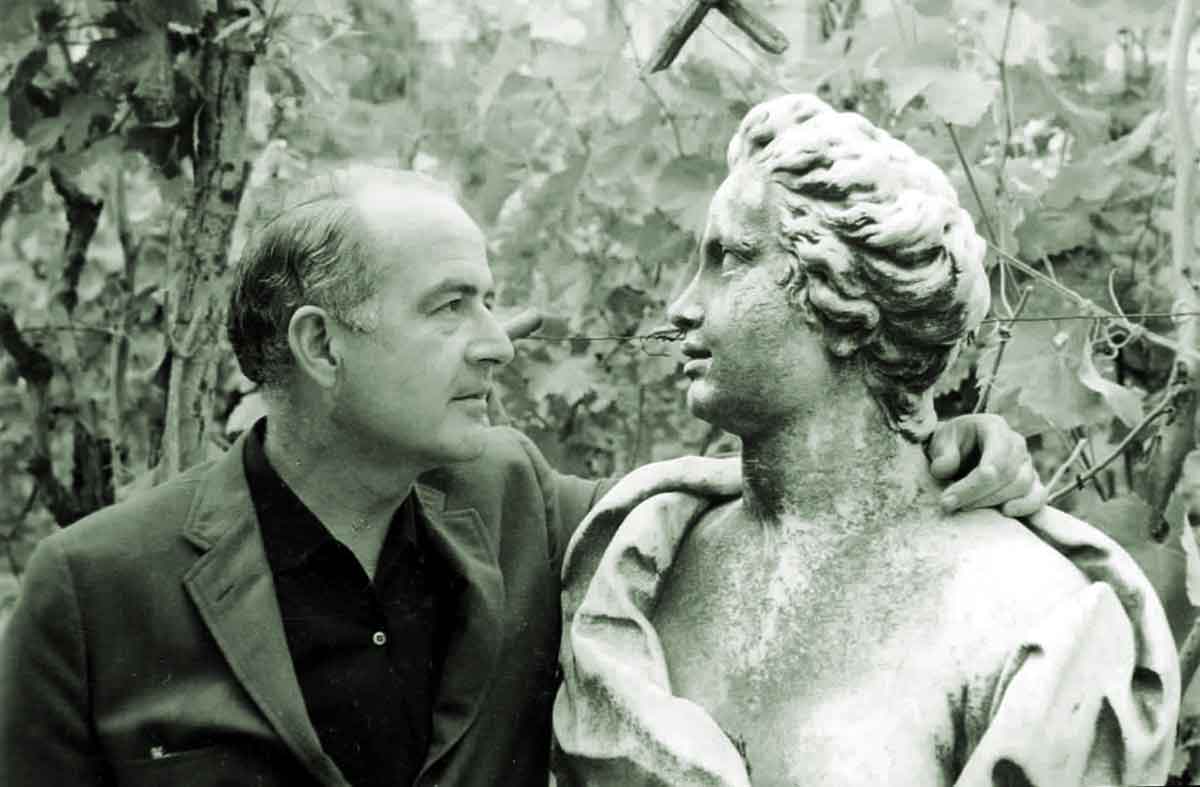
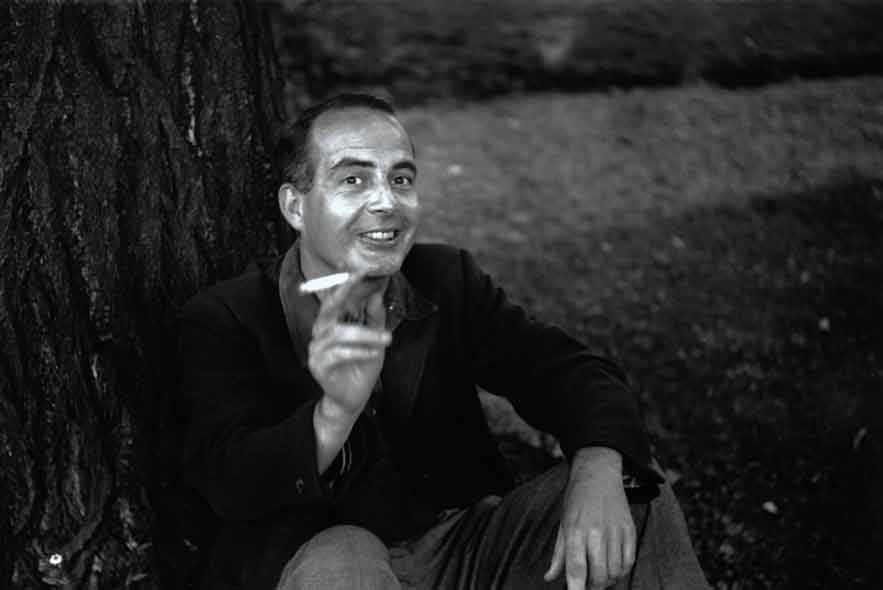
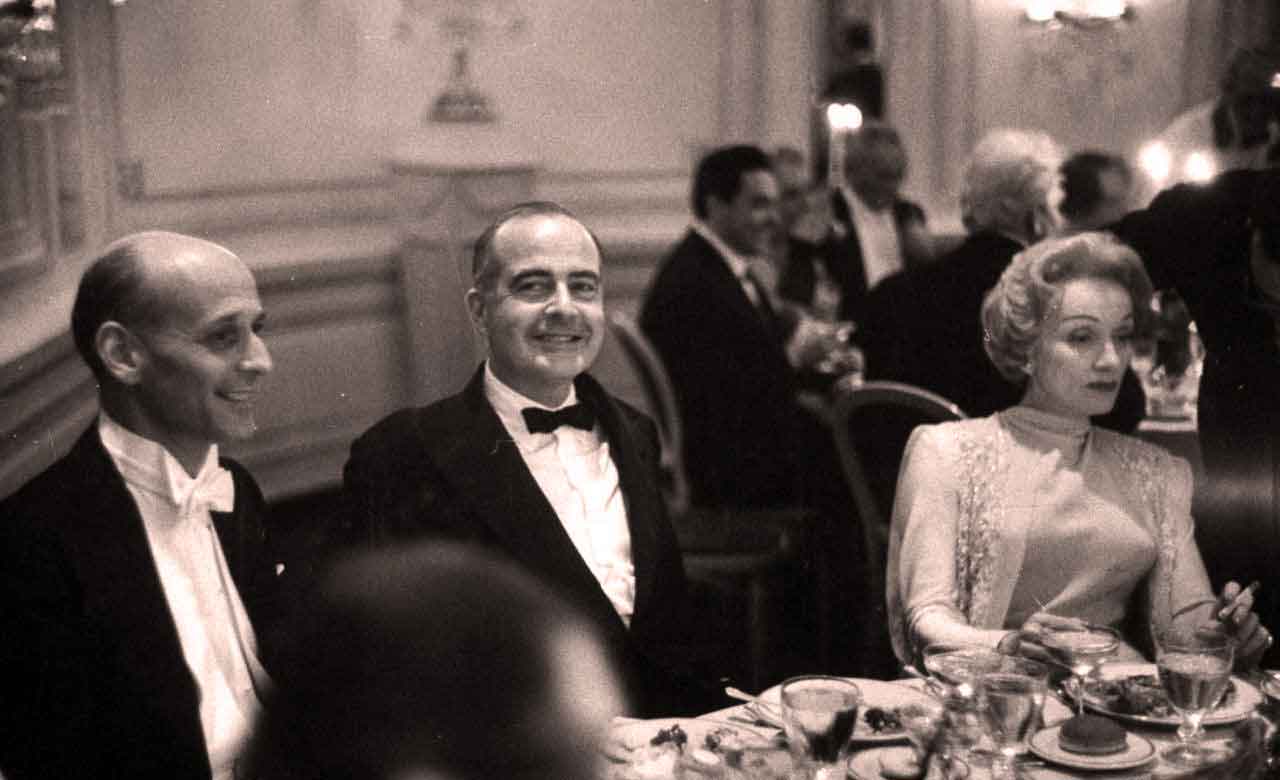
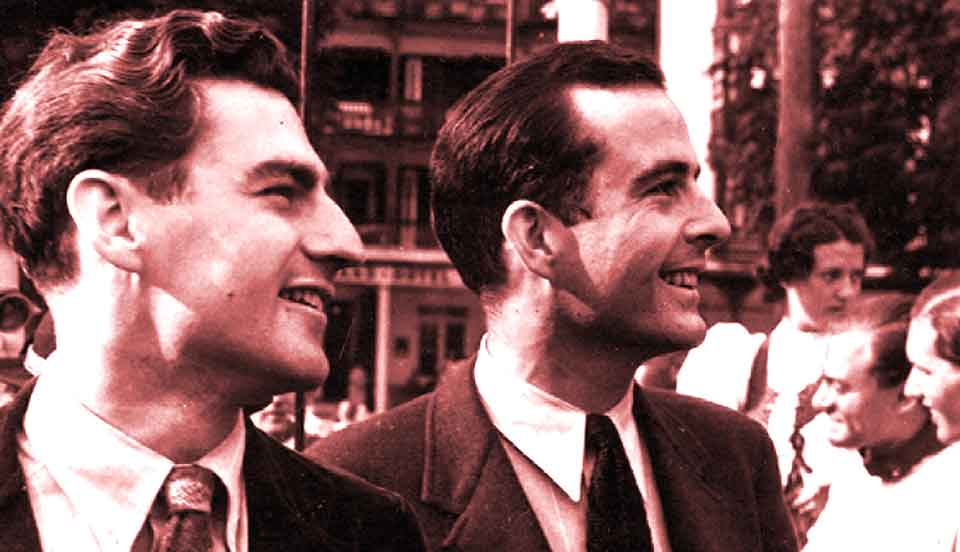
Loading...







Vanessa reigns over Germany ! From January to June 2019, two different productions in Magdeburg and Flensburg offer no less than ten opportunities to (re)discover this masterwork of modern opera.
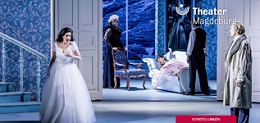
In our Documents section, focus on Samuel Barber, Absolute Beauty, the multi-award-winning documentary by Paul H. Moon.















A Hand of Bridge
« A Hand of Bridge » (Shawna Avinger, soprano / Janna Wächter, mezzo-soprano / Eric Banks, ténor / Glenn Guhr, baryton / Northstar Saxophone Orchestra, dir. Roger Nelson (arrangement Scott Granlund) Réalisation Curtis Taylor pour Vodvil Films, 2005)
« A Hand of Bridge » (Eugene Brancoveanu, Lisa Chavez, Andres Ramirez, Krista Wigle, Opera Parallèle Orchestra, Nicole Paiement, San Francisco 2013)
Vanessa
Vanessa at the Glyndebourne Festival 2018 (Emma Bell, Virginie Verrez, Edgaras Montvidas, Rosalind Plowright). Vidéo available until 02/14/2019.
Vanessa (Kiri Te Kanawa, Lucy Schaufer, David Maxwell Anderson, Rosalind Elias, Monte Carlo Opera, 2001)
Vanessa (Yun Jung Choi, Diana Axentii, Thorbjorn Gulbrandsoy, Helene Delavault, Jacques Bona, Orchestre-Atelier OstinatO, Jean-Luc Tingaud, staging director Bérénice Collet, Herblay, 2012)
« Vanessa » (Lauren Flanigan, Boston University Chamber Orchestra and Chamber Singers, William Lumpkin, chanteurs du College of Fine Arts, 28-09-2010)
« Vanessa - Must the Winter Come So Soon » (Marie Charpentier-Leroy, mezzo-soprano / Frédéric Rubay, piano / Conservatoire de musique de Paris, 9.12.2011, réalisation Paul H. Moon pour ZenViolence Films)
Adagio for Strings
« Adagio pour cordes » (In memorial Charlie Hebdo, Trafalgar Square, 1-8-2015)
« Adagio for Strings » (Quatuor Debussy)
« Adagio for Strings » (OS Detroit, Leonard Slatkin, 08-03-2013)
« Adagio for Strings » (OS BBC, Leonard Slatkin, Prom's Londres, 15-09-2001)
« Adagio for Strings » (National Symphony Orchestra USA, Mstislav Rostropovich, Moscou, Grande Salle du Conservatoire Tchaïkovski, 13-02-1990)
« Adagio for Strings » (Cypress String Quartet, 9-12-2011)
« Adagio for Strings » (Camerata du Rhône ,janvier 2010)
Violin Concerto
« Violin Concerto » (Anne Akiko Meyers, Orchestre philharmonique de Slovénie, George Pehlivanian)
« Violin Concerto » (Gil Shaham, BBC SO, David Robertson, Prom's Londres 26 -8-2010)
« Violin Concerto » (Giora Schmidt, OP Israël, Itzhak Perlman, juin 2004)
« Violin Concerto » (Olivier Charlier, Orchestre Philharmonique de l'Oural, Dmitri Liss, Folle Journée Nantes, 01-02-2014)
Piano Sonata
« Piano Sonata » (Yeol Eum Son, Concours Van Cliburn, 2009)
« Piano Sonata » (Evgeny Kissin, 21-12-2011, Tel Aviv)
Finale Allegro con spirito of the « Piano Sonata » (Arisa Sakai, (Concours Reine-Elisabeth, Studio 4, Flagey, 10-05-2013)"
Adagio mesto of the « Piano Sonata » (John Browning, concours Reine-Elisabeth, Palais des Beaux-Arts, Bruxelles, 30-05-1956)
The complete catalogue of Samuel Barber's works consists of 50 opus and 120 various compositions bearing no opus number, among which the American biographer of Barber, Ms Barbara Heyman, lists almost 70 art songs.
The two catalogues below present Barber's works, sorted either by dates or by musical category.
Named after Barber's famous home in Mount Kisco, Capricorn, the French Samuel Barber Society, was established in February 2009 in Paris by Pierre Brévignon, with five honorary members : composers John Corigliano and Nicolas Bacri, musicologist Henry-Louis de la Grange, radio producer Anne-Charlotte Rémond and conductor Jean-Pierre Marty. Its aims are :
To become a member of Capricorn, please click here.
Comments, questions & suggestions : associationcapricorn@gmail.com
« A Composer For Our Time »
« Samuel Barber : A Forgotten Neo-Romantic Great »
« A Sideways-Looking Genius »
The organist Iain Quinn tells the story of his discovery of the early Christmas Eve cantata.
« The Saddest Music Ever Written »
Official website of the music publisher Schirmer
The website of the Curtis Institute of Music in Philadelphia.
A website dedicated to violinist Iso Briselli recounting the amazing genesis of the Violin Concerto.
« Echoes of Ireland »
An overview of Barber's chamber music
« Samuel Barber »
The Library of Congress, at Washington, offers a thorough exploration of the Barber Archives

All the texts on this website are © Pierre Brévignon / Association Capricorn, and cannot be reproduced without prior authorization (associationcapricorn@gmail.com).
Photos© Pierre Brévignon : 1, 2, 12, 13, 17, 30, 36 / © Curtis Institute of Music, Philadelphie : n°5-11 / © LIFE Magazine : n°18 (Alfred Eisenstadt), 20 (Nina Leen), 34 (Gordon Parks), 38 / © Ruth Orkin Photo Archive : n°19 / © Metropolitan Opera, New York : n°31, 37 (Louis Mélançon) / © Opéra de Monte- Carlo : n°32 / © Magnum Photo : n°28 (Herbert List) / © Saturday Review : n°42 / © Columbia Records : n°16, 24, 33 / © Duke University Photograph Collection : n°41 (William Gedney) / © Yale University, Frederick and Rose Plaut Papers : n°26 / Collection privée de M. Tom Krause : n°40 / Collection privée de Mme Susan Sugar : n°3, 35, 39 / Collection privée de M. Ulrich Klabunde : n°4, 28 / Collection privée de M. Victor Kraft : n°25 / DR ou non identifié : n°14, 15, 21-24, 27, 29
Audio/video documentsAll the identified audio/video documents on this website are credited within the captions. Should you recognize any of them as your content, please contact us : associationcapricorn@gmail.com.
Martha Graham, Isamo Noguchi and Cave of The Heart
Lecture by Janet Eilber, artistic director of the
Martha Graham Center of Contemporary Dance.
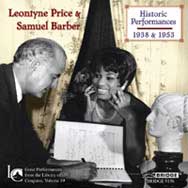
Barber plays the piano for his muse when he and Leontyne Price perform the Hermit Songs at the Library of Congress in Washington in October 1953. He also sings in a recital for his fellow-students at the Curtis Institute of Music for Christmas 1938. The program provides an idea of the kind of singing career Barber could easily have embarked upon.


Barber plays the piano for his muse when he and Leontyne Price perform the Hermit Songs at the Library of Congress in Washington in October 1953. He also sings in a recital for his fellow-students at the Curtis Institute of Music for Christmas 1938. The program provides an idea of the kind of singing career Barber could easily have embarked upon.

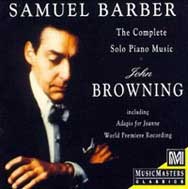
Inaccurately called The Complete Solo Piano Music. (the solo version of the Souvenirs, the second Interlude and some early pieces are missing), this album is a great introduction to Barber's piano compositions by one of his old-time accomplice: John Browning, soloist and dedicatee of the Piano Concerto who also premiered the Nocturne.

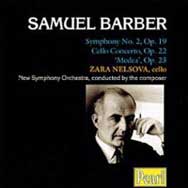
A very rare opportunity to hear Barber conducting an orchestra. With the lyrical and engaging interpretation of Zara Nelsova – preferred to Raya Garbousova, who yet premiered the work -, Barber’s Cello Concerto is a compelling experience. The Symphony No. 2 is an equally rare addition : composed during the war, its score was destroyed by Barber some twenty years later. Only the second movement will survive to become Night Flight.


The absolute gem! Consisting of 1935-1947 recordings, this CD features most notably two historical archives : Barber singing at 25 his own Dover Beach with the Curtis String Quartet, and the 1942 première of the Adagio by Toscanini conducting the NBC Symphony Orchestra.

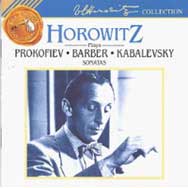
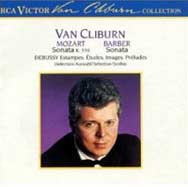
Six months after its première in Havana, Horowitz plays a highly-charged version of the Piano Sonata, unfortunately weakened by the very poor quality of the recording. His rather gutsy enthusiasm for this composition reminds us that he’d personally asked Barber to write the virtuoso final Fugue. Recorded by the same label, the American Van Cliburn gives another historical interpretation of the Sonata. Paying more attention to its lyrical aspects rather than its fireworks effects, this pupil of Rosina Lhévinne underscores the filiation between Barber’s work and the Russian romantic school of piano.



Six months after its première in Havana, Horowitz plays a highly-charged version of the Piano Sonata, unfortunately weakened by the very poor quality of the recording. His rather gutsy enthusiasm for this composition reminds us that he’d personally asked Barber to write the virtuoso final Fugue. Recorded by the same label, the American Van Cliburn gives another historical interpretation of the Sonata. Paying more attention to its lyrical aspects rather than its fireworks effects, this pupil of Rosina Lhévinne underscores the filiation between Barber’s work and the Russian romantic school of piano.

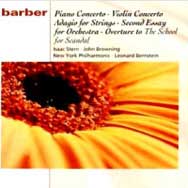
Stern and Bernstein - Barber’s “best enemy” – give an extremely melancholic and idiomatic reading of the Violin Concerto. The Piano Concerto by Browning and Szell stands undeniably a notch above the recording Browning and Leonard Slatkin would make a few years later.

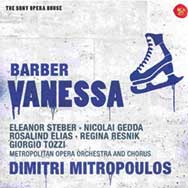

Four months after its much acclaimed première at the Met, this recording features the same outstanding cast (also available under the reference RCA Victor 7899-2-RG). Another recording of the European production at the 1958 Salzburg Festival (same cast except for Regina Resnik, replaced by Ira Malaniuk) is available with Orfeo (« Festspiel Dokumente », C635-0621).

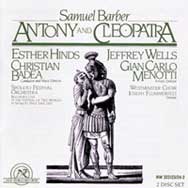
Recorded 17 years after the fateful première of the opera, this revised version of Antony and Cleopatra is shortened by more than an hour. This beautiful composition has been unjustly neglected, as evidenced in this production recorded during the 1983 Spoleto Festival. Currently, this is the only existing recording of Antony and Cleopatra.

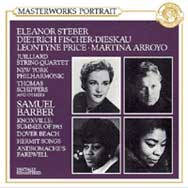
A historical anthology. Along with a glamorous studio version of the Hermit Songs by Barber and Price, it features two masterpieces interpreted by their dedicatee : the delicate and touching Knoxville, Summer of 1915 performed by Eleanor Steber and a white-hot Andromache’s Farewell by Arroyo and Schippers. Rarely heard performing Barber’s compositions, the German Fischer-Dieskau renders Dover Beach with a beautiful Liedersanger sobriety.


The two arias of Cleopatra («Give Me Some Music » and « Give Me My Robe ») are presented together in what could be seen as Barber’s first attempt at saving his doomed opera, following the disaster of the inaugural night of the new Metropolitan Opera. Leontyne Price is also “back on the scene of the crime” as the Queen of Egypt and gives a definite interpretation of these musical jewels. For Knoxville, she rises to the same level of interpretative perfection as Eleanor Steber reached.

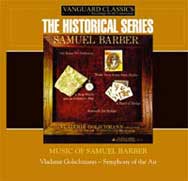
This mélange of works for orchestra and voice features a couple of rare recordings : A Stopwatch and an Ordnance Map for men’s choir, brass and percussions on a poem by Stephen Spender which relates the death of a soldier during the Spanish Civil War; and A Hand of Bridge, a ten-minute opera giving voice to the stream of consciousness of two couples playing bridge. Gian Carlo Menotti leaves his mark on the libretto as in the casting of Patricia Neway, one of his emblematic singer. To this day, this mini-opera remains an all-time favorite of many students in the American colleges of music.
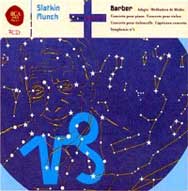
The three concertos conducted by Slatkin form a totally coherent modern triptych, dominated by Isserlis’s version of the Cello Concerto. A great fan of the ballet Medea, in his Boston days, Munch used to get on his soapbox and expound upon its abridged setting, Meditation and Dance of Vengeance.


The three concertos conducted by Slatkin form a totally coherent modern triptych, dominated by Isserlis’s version of the Cello Concerto. A great fan of the ballet Medea, in his Boston days, Munch used to get on his soapbox and expound upon its abridged setting, Meditation and Dance of Vengeance.
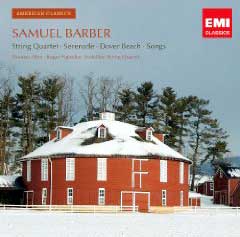
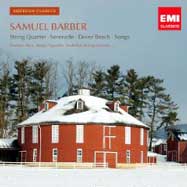
The English baritone gives an unusual and unexpectedly convincing version of these works, highlighting their similarities with the vocal music of Britten. The Endellions prove equally convincing in their very homogeneous rendition of the String Quartet – where others (eg. the Borodine, the Lindsays, the Tokyo String Quartet) have chosen, in a more conventional fashion perhaps, to focus on the central Adagio.

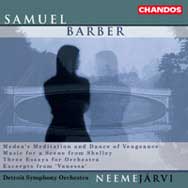
This orchestral anthology is taken from the Barber almost-complete works published by Chandos. It is particularly interesting in that it features the three Essays, rarely found together on the same album. The Estonian conductor performs these rather elusive scores like Nordic symphonic poems, somewhere between Nielsen and Sibelius. An altogether very convincing album.

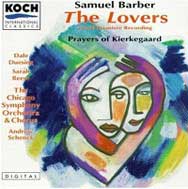
Andrew Schenck died in 1992, aged 51. He loved Barber’s music and, during all his career, conducted it relentlessly - with various successes. This very sensual, almost crude at times, version of the cantata The Lovers ranks among his best recordings. His Prayers of Kierkegaard however do not match the quality of Robert Shaw’s and Jorge Mester’s renditions (Telarc / Albany).

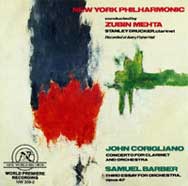
This live recording documents the first concert Mehta gave as newly appointed Musical Director of the New York Philharmonic. On that September 14th, 1978, he conducts the première of Barber’s last (fully completed) work, “an absolutely abstract, essentially dramatic music”, as described by the composer himself. The 3rd Essay fits with the neo-romantic aspects of the first two Essays as well as with the more chaotic and jagged rhythm of the Piano Concerto.

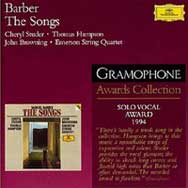
An absolute must-have for all Barber fans. Initiators of the project, Browning and Hampson have added to the existing ten cycles ten early songs never released before. Cheryl Studer gives a brilliant interpretation of the Hermit Songs, while Hampson delivers a harrowing Despite and Still. With the Emerson Quartet, his Dover Beach version stands out as the jewel of this remarkable recording.

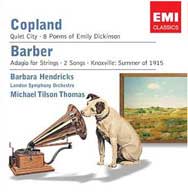
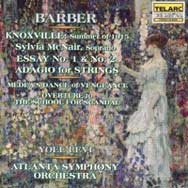
Two interpretations of Knoxville Summer of 1915 that complement each other rather well : a theatrical, dramatic version by Barbara Hendricks and a more contemplative and nostalgic version by Sylvia McNair. In addition, the Telarc album features beautiful orchestral performances.



Two interpretations of Knoxville Summer of 1915 that complement each other rather well : a theatrical, dramatic version by Barbara Hendricks and a more contemplative and nostalgic version by Sylvia McNair. In addition, the Telarc album features beautiful orchestral performances.

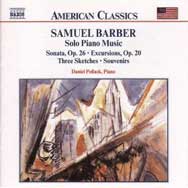
The American pianist Daniel Pollack, who has premiered the Piano Sonata in Moscow in 1958 and in China, offers with this album a contrasted panorama of Barber's works. The bitter-sweet nostalgia of the Souvenirs cycle finds here a perfect reading, and never has the Ballade been delivered with such an aristocratic poignancy.

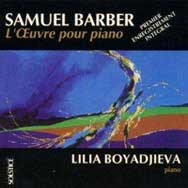
The American pianist Daniel Pollack, who has premiered the Piano Sonata in Moscow in 1958 and in China, offers with this album a contrasted panorama of Barber's works. The bitter-sweet nostalgia of the Souvenirs cycle finds here a perfect reading, and never has the Ballade been delivered with such an aristocratic poignancy.

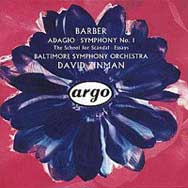
A perfect introduction to Barber’s orchestral works, with an electrifying First Symphony . The high quality and somewhat analytical recording of the Baltimore orchestra allows for strings and brass alike to sound as soft or boisterous as they possibly could.

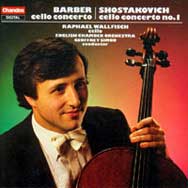
Published in 1982, this version of the Cello Concerto is the first recorded version following the initial one by Zara Nelsova and Samuel Barber. The chamber-like texture of the orchestra provides an ideal cocoon to the energetic and accurate interpretation of the English cellist. While Wallfisch takes into account the dramatic aspect of the work, he successfully chooses to focus on its elegiac tone.

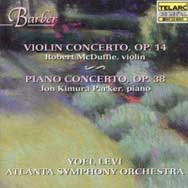
The American violinist Robert McDuffie, who received the advice of Barber in person regarding his playing of the Concerto, gives a wonderful reading of Barber’s work, in a perfectly balanced interpretation between the sentimental and the virtuoso. John Kimura Parker’s version of the Piano Concerto sounds however somewhat distant and disembodied. The Browning/Szell version remains preferable.

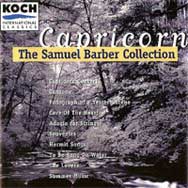
A high-quality compilation of several chamber works recordings : the exuberant >Capricorn Concerto expresses a typically neo-classical sprightliness thanks to a particularly eloquent Arioso Wind Quintet ; the surprising transcription for clarinet and piano of the Hermit Songs eventually proves very pleasing, and could certainly be an inspiration to musicians looking for unusual works to perform …
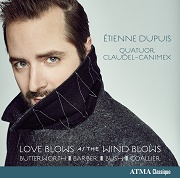
Barber's Dover Beach has been graced by 1st class performances in a plethoric discography, from Fischer-Dieskau to Gerald Finley and Thomas Allen. In his first solo album, the Quebecker baritone Étienne Dupuis is overshadowed by his prestigious predecessors. If his voice has a velvety timbre and an impressive largeness, the phrasing could be more nuanced to express all the juvenile intensity of Matthew Arnold's poem. Here, the text is delivered with a curious detachment. The accompaniment by the Claudel-Canimex String Quartet sounds equally atonic - as well as their performance of the Adagio, more cerebral than visceral. The rest of the program offers a refreshingly unusual selection of works for voice and string quartet.


Barber's Dover Beach has been graced by 1st class performances in a plethoric discography, from Fischer-Dieskau to Gerald Finley and Thomas Allen. In his first solo album, the Quebecker baritone Étienne Dupuis is overshadowed by his prestigious predecessors. If his voice has a velvety timbre and an impressive largeness, the phrasing could be more nuanced to express all the juvenile intensity of Matthew Arnold's poem. Here, the text is delivered with a curious detachment. The accompaniment by the Claudel-Canimex String Quartet sounds equally atonic - as well as their performance of the Adagio, more cerebral than visceral. The rest of the program offers a refreshingly unusual selection of works for voice and string quartet.

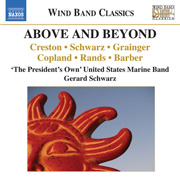
This live concert of the United States Marines Band offers the opportunity to discover a new side of Barber’s music. If it appears quite trivial and almost ironical with its pompous accents, the Commando March (1943) is straightforward and efficient in its primary task : support the morale of the troops (it will be Barber’s most performed work in the USA, with the Adagio for Strings, during World War II). More intriguing and mesmerizing, Medea’s Meditation and Dance of Vengeance reveals the real « warlike » facet of Barber’s inspiration. Here, the music – drawn from a ballet commissioned by Martha Graham – switch abruptly from hypnotical stillness to Dionysian frenzy. The wind band arrangement (with piano) by Frank Hudson underlines all the sharpness, syncopations and angular rythms of this splendid symphonic poem. The virtuosos of the President’s own are the perfect advocates for this ambitious program (Bernard Rands’Ceremonial and Aaron Copland’s Emblems are just as fascinating).

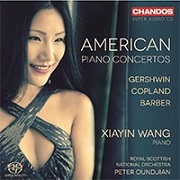
Barber's Piano Concerto is a strange beast, a monster with many heads, difficult to seize and master. The pianists who had the courage to confront it can be counted on the fingers of two hands (one hand is enough as far as the first-rate performances are concerned). The young Chinese Xiayin Wang, whose love for American music seems to be engraved in her DNA (Gershwin, Earl Wild and Richard Danielpour bear the lion's share in her repertoire), succeeds brilliantly in taming this pianistic Hydra. Intensely poetic in the Canzone, with its dreamlike lullaby rythm, she tackles the baffling introduction, full of shadows and unanswered questions, and the conclusive Allegro molto, driven by a disheveled motorism, with a extra touch of soul. Under Peter Oundjian's baton, the RSNO deploys a range of radiant colours, in its tempetuous roarings as well as in its intimate murmurs. A feast of a recording - Copland's and Gershwin's concertos being just as accomplished !

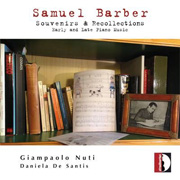
After a splendid Piano Concerto, Giampaolo Nuti confirms he's a great performer of Barber's music. His new album Souvenirs & Recollections includes no less than seven world premiere recordings of works composed between the age of 13 and 15*. Especially interesting are the moving Andante religioso and Petite Berceuse, finely written, a Prelude to a Tragic Drama emphatic but never hollow, and the three Essays composed in 1926. This triptych, not to be confused with the three Essays for Orchestra, proves to be a fascinating sonata in disguise : the Andante, based on an insidious ostinato, sounds strangely ominous ; the Allegro molto ("like a very hot summer night", as noted by Barber) would be the scherzo, restless and falsely cheerful ; the last movement, Con moto, is a solemn choral spiced up with a few dissonances... Let's hope these enigmatic pieces, somewhere between Medtner and Martinu, will inspire other pianists as adventurous as Nuti. The last part of the program consists in three mature works : the Souvenirs cycle, played with the right kind of refined humor by Nuti and De Santis, After the Concert, a deliciously anachronistic waltz, and the Ballade, ultimate opus of Barber's catalogue, heartbreaking and exhausted piece of music tinged of crepuscular poetry. A wonderful disc - and a booklet, one must add, particularly interesting signed by Aloma Bardi (president of ICAMus). Now, we must hear Giampaolo Nuti in the monumental Piano Sonata ! [Read the booklet]

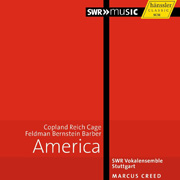
It's quite surprising to find associated, on the same CD cover, the name of Barber with two mavericks such as Steve Reich and Morton Feldman. Yet, there is an implicit connection between the severe expressionism of Barber's war piece, A Stopwatch and an Orndance Map, the obsessive loop of Proverb and the haughty statism of Rothko Chapel. The three works are the soundtracks of a mysterious ceremonial, both uncanny and dramatic, and they attain their maximal expressivity with a remarkable economy of means. A very fine album of American choral music, proving once more the excellence of Marcus Creed and his SWR Vokalensemble Stuttgart.

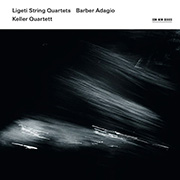
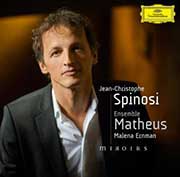
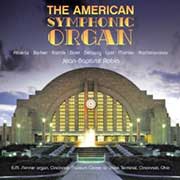
Here are 3 versions of the world-famous Adagio, under three different guises. The slow movement of Barber's String Quartet is performed by the Keller Quartet with György Ligeti's two String Quartets. The link between the neo-romantic elegy of the American and the tempetuous folklorism of the Hungarian appears quite far-fetched, but the performance is passionate, adventurous, with a high-strung (bordering on out-of-tone) climax, and a very sensuous ending. Too bad the Keller chose to not record the complete quartet... The Adagio has been recorded in various arrangements but, unless we're mistaken, this organ transcription by Jean-Baptiste Robin is a world-premiere on disc. Alas, the rendition sounds strangely sluggish, monochromatic, drown in a problematic reverberation. Maybe the organ is not the right instrument for this work ? The divine surprise comes from the French Ensemble Matheus and its conductor Jean-Christophe Spinosi. Mainly known for its brightly performances of baroque music on period instruments, it has recorded for the prestigious Deutsche Grammophon a thematic program resolutely off the beaten track : the Adagio in its string orchestra version dialogues with the Bach family (Johann Sebastian and Johann Christoph), Shostakovich and Nicolas Bacri. From the very first measures, Barber's intense dirge sounds like a baroque lamento. All through the arch-like architecture of the work, the fortrightness and the sharpess of the strings are evocative of the young Barber's most vivid inspirations : Bach, of course, but also Monteverdi and the English madrigalists. This Adagio alone would justify the purchase of this disc ; but don't miss the other works of the program, they're all first-class performances !




Here are 3 versions of the world-famous Adagio, under three different guises. The slow movement of Barber's String Quartet is performed by the Keller Quartet with György Ligeti's two String Quartets. The link between the neo-romantic elegy of the American and the tempetuous folklorism of the Hungarian appears quite far-fetched, but the performance is passionante, adventurous, with a high-strung (bordering on out-of-tone) climax, and a very sensuous ending. Too bad the Keller chose to not record the complete quartet... The Adagio has been recorded in various arrangements but, unless we're mistaken, this organ transcription by Jean-Baptiste Robin is a world-premiere on disc. Alas, the rendition sounds strangely sluggish, monochromatic, drown in a problematic reverberation. Maybe the organ is not the right instrument for this work ? The divine surprise comes from the French Ensemble Matheus and its conductor Jean-Christophe Spinosi. Mainly known for its brightly performances of baroque music on period instruments, it has recorded for the prestigious Deutsche Grammophon a thematic program resolutely off the beaten track : the Adagio in its string orchestra version dialogues with the Bach family (Johann Sebastian and Johann Christoph), Chostakovitch and Nicolas Bacri. From the very first measures, Barber's intense dirge sounds like a baroque lamento. All through the arch-like architecture of the work, the fortrightness and the sharpess of the strings are evocative of the young Barber's most vivd inspirations : Bach, of course, but also Monteverdi and the English madrigalists. This Adagio alone would justify the purchase of this disc ; but don't miss the other works of the program, they're all first-class performances !




Here are 3 versions of the world-famous Adagio, under three different guises. The slow movement of Barber's String Quartet is performed by the Keller Quartet with György Ligeti's two String Quartets. The link between the neo-romantic elegy of the American and the tempetuous folklorism of the Hungarian appears quite far-fetched, but the performance is passionante, adventurous, with a high-strung (bordering on out-of-tone) climax, and a very sensuous ending. Too bad the Keller chose to not record the complete quartet... The Adagio has been recorded in various arrangements but, unless we're mistaken, this organ transcription by Jean-Baptiste Robin is a world-premiere on disc. Alas, the rendition sounds strangely sluggish, monochromatic, drown in a problematic reverberation. Maybe the organ is not the right instrument for this work ? The divine surprise comes from the French Ensemble Matheus and its conductor Jean-Christophe Spinosi. Mainly known for its brightly performances of baroque music on period instruments, it has recorded for the prestigious Deutsche Grammophon a thematic program resolutely off the beaten track : the Adagio in its string orchestra version dialogues with the Bach family (Johann Sebastian and Johann Christoph), Chostakovitch and Nicolas Bacri. From the very first measures, Barber's intense dirge sounds like a baroque lamento. All through the arch-like architecture of the work, the fortrightness and the sharpess of the strings are evocative of the young Barber's most vivd inspirations : Bach, of course, but also Monteverdi and the English madrigalists. This Adagio alone would justify the purchase of this disc ; but don't miss the other works of the program, they're all first-class performances !

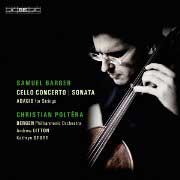
It was quite obvious when he conducted, a few years ago, the Dallas Symphony Orchestra in the Piano Concerto (with Leon McCawley), and this new recording now confirms it : Andrew Litton is a great (and unsung) Barberian conductor. Under his baton, the Bergen Philharmonic delivers a powerful and heartbreaking rendition of both the Adagio for Strings and the Cello Concerto. If the Violin Concerto is really Barber's "war concerto", this one, composed in 1945, sounds like a "Hymn for Peace", with its dream-like Andante and its splendid lyrical themes. Christian Poltéra's cello is a marvel of delicacy and strength, but achieves also a youthful impetuosity in the Cello Sonata with his favorite "partner in crime", the pianist Kathryn Stott. Three modern references in one CD : what more could a Barberian fan ask for ?

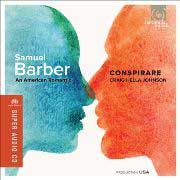
For too many years, The Lovers, a striking cantata composed by Barber at the end of his life on poems by Pablo Neruda, has been available only in one recording. At long last, a modern version is now released, and it comes in a new guise : originally composed for a large orchestra, the work has been transcribed (by Robert Kyr) for a small instrumental ensemble, to clarify the dense polyphony of the music and, in a way, duplicate the sense of intimacy expressed in the poems (take from Twenty Love Poems and a Song of Despair). Unfortunately, Barber's lyricism sounds a bit thin here, and the almost telluric eroticism of the Chilean poet is quickly forgotten. The voices of Conspirare are perfectly balanced, with a great attention to nuances and dynamics, but the soloist David Farwig fails to really perform the words he sings. A "semi-success", this new recording of The Lovers is luckily complemented by wonderful renditions of choral pieces, from the most famous (Agnus Dei, Sure on this shining night) to the not-so-known (opp.8 and 42) or almost experimental (the brief A Stopwatch and an Ordnance Map, with its impressive timpani accompaniment).
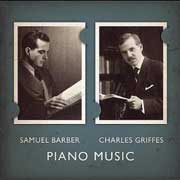
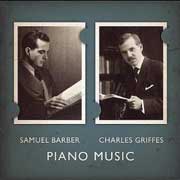
For his first CD, the Dutch pianist Lodewijk Crommelin has put together a very original and intelligent compilation of neo-romantic works by two American composers of different generations. While Charles Griffes' music can be described as impressionistic, Barber's is more obviously eclectic and daring. Crommelin tackles Barber's Sonata with very impressive touch and rythmic instinct, sounding at time almost haughty - which is fine with this intimidating masterwork. On the other side, the subtler pieces (Nocturne and Ballade) sound a little bit harsh. Maybe the instrument is to blame, with its narrow range of colors... The evanescent poetry of Griffes' pieces gets a little bit lost in translation. Nevertheless, a very promising album, offering a fascinating overview of America's music for piano of the XXth century.

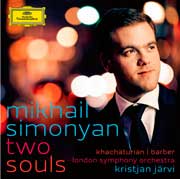
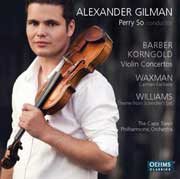
More than ever, Barber's music comes alive thanks to a young generation of artists. Alexander Gilman, 29 years old, and Mikhail Simonyan, 26, offer two distinct approaches of the Violin Concerto : sensuously vibrant for the first one, with a shimmering orchestral background, breathtakingly virtuoso for the second one, with an unbridled London Symphony Orchestra under the hot-headed command of Kristjan Järvi. The Korngold/Waxman/Williams works by Gilman sound more interesting than Simonyan's rendition of Khachaturian's Violin Concerto, but the two CDs remain highly commandable !
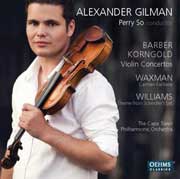


More than ever, Barber's music comes alive thanks to a young generation of artists. Alexander Gilman, 29 years old, and Mikhail Simonyan, 26, offer two distinct approaches of the Violin Concerto : sensuously vibrant for the first one, with a shimmering orchestral background, breathtakingly virtuoso for the second one, with an unbridled London Symphony Orchestra under the hot-headed command of Kristjan Järvi. The Korngold/Waxman/Williams works by Gilman sound more interesting than Simonyan's rendition of Khachaturian's Violin Concerto, but the two CDs remain highly commandable !

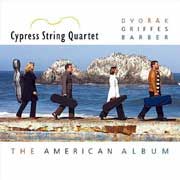
Flanked by the world-famous "American" String Quartet by Dvorák and the rare Sketches by the young Charles Tomlinson Griffes (a pupil of Engelbert Humperdinck in Berlin), the neo-brahmsian String Quartet by Barber confirms the "Old World" flavor of this album. The Cypress String Quartet performs the Op.11 with an impressively homogeneous sound signature, but doesn't really achieve to express the whole dramatic range of the score (cf. the almost anticlimactic rendition of the Adagio). A neat performance, definitely more "chamber" than "theater" music... [The Cypress String Quartet website]

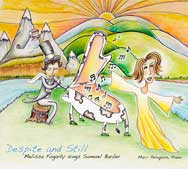
When a young singer choses an all-Samuel Barber program for her second solo album, it says a lot about her artistic integrity as well as the importance of Barber's output in modern vocal music. And Melissa Fogarty pushes the artistic envelope further by selecting, next to the famous Hermit Songs and Sure on this shining night, two particularly arduous song-cycles, Despite and Still op.41 and Three Songs op.45, composed in the aftermath of Antony and Cleopatra's disaster. With her light soprano voice and nice vibrato, Ms Fogarty doesn't succeed entirely in expressing the drama behind theses works, but she tackles the more playful songs (The Heavenly Banquet, The Monk and his Cat, Nuvoletta, Monks and Raisins, A Green Lowland of Pianos) with impressive authority. Last but not least, her impeccable diction and Marc Peloquin's tactful accompaniment underline ideally the poetic quality of the texts. [Melissa Fogarty' s website]

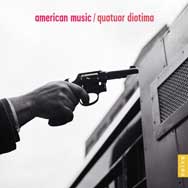
Usually - and unimaginatively - paired with Dvorák's "American" String Quartet or Schubert's "The Maiden and the Death", Barber's Opus 11 is at last confronted in this album with two touchstones of American chamber music of the XXth century. The French musicians of the Diotima Quartet tackle this work and its famous Adagio on the hedonistic side : their rendition underlines first and foremost the sheer melodic beauty of Barber's music, saving expressionnism and drama for Reich's and Crumb's works. Three visions of America for a highly recommended CD. [Article by Michael Quinn, The Classical Review]

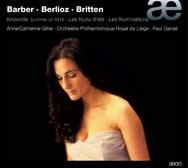
From Leontyne Price to Measha Brueggergosman, from Eleanor Steber to Barbara Hendricks, every single performer of Knoxville Summer of 1915 has talken about the autobiographical shades of the work, deeply related to their own childhood memories. The Belgian soprano Anne-Catherine Gillet makes no exception to this rule, even if she's not born on the same side of the Atlantic. The first French-speaking soprano to record Barber's "lyrical rhapsody", she feels as if "Barber had written it for [her]", and you certainly can hear it in this album, whose three works revolve about the theme of lost innocence. Her charming bright voice has also a deeper quality where nostalgia and Sehnsucht can be heard. Paul Daniel conducts the Belgian orchestra with gusto and subtelty, allowing it to sound as clearly as a chamber ensemble. The perfect match for Barber's inspired music and James Agee's heart-rending lyrics...

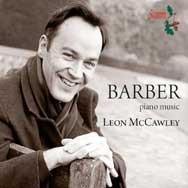
Almost fifteen years ago, the musical world discovered a young English pianist through a dazzling Samuel Barber album (see below, "The Young Generation"). This year, after touring in England and in the USA for Barber's centennial, Leon McCawley revisits the composer's music, adding to the usual program the Sketches, three delightful early pieces, and the second Interlude, where Barber pays sumptuously his debt to Brahms. The pianist's talent is as versatile as ever, but his new approach underlines brilliantly the dramatism of the Sonata, while the subtle enigma of the Ballade takes a new resonance, almost schumannesque, under his fingers. The high quality of the sound recording gives an added value to this album, undoubtedly the most satisfying modern version of Barber's pianistic output. [Details on Somm's website] [International Record Review]

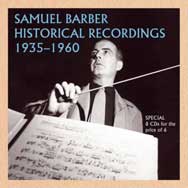
This extraordinay boxset is a cornucopia of rare archives documenting more than 25 years of historical recordings, from Dover Beach sung by a young baritone named Samuel Barber to the world premiere of Die Natali. The casting is of the utmost artistic quality and the program offers several gems : the original version of the Violin Concerto and its revised version, the String Quartet with its original third movement or a rehearsal of the Symphony No. 2 with Barber conducting the Boston Symphony Orchestra ! [works & artists]

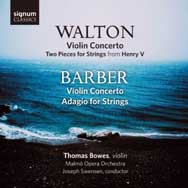
The coupling of Barber and Walton in the same album is an excellent idea. The two composers, perfectly contemporary, share the same stylistic qualities, mixing a traditional idiom with an acquired taste for modernism. Thomas Bowes, leader of the London Sinfonietta, gives a clean-cut rendition of Barber's Concerto, highly recommendable, though lacking maybe of a gusto and madness found in Gil Shaham's, James Ehnes' and Vadim Gluzman's peformances. The Malmö Opera Orchestra sounds much more at ease with the virtuso motorism of the Concerto than with the static intensity of the Adagio...

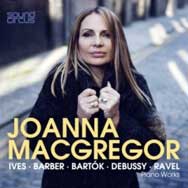
This 2-CDs album offers several milestones of the piano music composed in the first half of the XXth century. The English pianist Joanna MacGregor delivers a very dramatic performance of Barber's Piano Sonata, underlining brilliantly its numerous contrasts (the ominous Allegro energico and slow movement counterbalancing the quicksilver quality of the scherzo and the breathtaking motorism of the fuga). She's equally at ease with the humorous Excursions, where her lightness of touch works wonders. A fascinating account of Barber's piano output, and an ideal way to explore the modern musical trends of XXth century music.

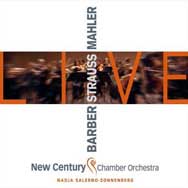
This very consistent (though a little bit too brief) program features the newly founded NCCO, whose leader is the Italo-American violonist Nadja Salerno-Sonnenberg. Its approach of the Adagio for Strings is at first surprising, with a very slow tempo (at 10', just between Bernstein and Celibidache), but it proves extremely effective : where Lenny and his musicians (from the LA Philharmonic and the NY Philharmonic, no less) sound erratic and at a loss, the NCCO (without conductor, and live) gives a convincing performance, stretching with extreme clarity the subtle polyphony of the strings and handling with confidence the heart-wrenching crescendo. Even the silence after the famous climax is perfectly timed, letting Barber's music resonate without completely dying... Very powerful and inspired.

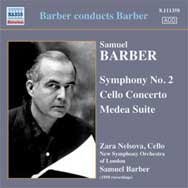
We knew Barber as a singer and pianist : in this new release by Naxos, he conducts three of his latest works in a historical Decca recording of December 1950 - including the Symphony No. 2, that he'd choose a few years later to withdraw. Very intense and risky performances, enhanced by a wonderful audio restoration, far superior to the similar album published by Pearl. Review by Audiophile Audition

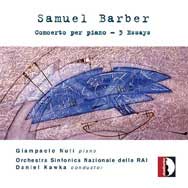
A rare pianist with a carefully chosen repertoire (Schnittke, Chostakovitch, Alkan, Busoni, Berio), Giampaolo Nuti shares an amazing affinity with Barber's music. This recording shows him equally at ease in the dissonnant, elegiac or motoristic moments of the Piano Concerto. The RAI Symphony Orchestra under Daniel Kawka's baton give a tremendous performance of the 3 Essays, eloquently enhancing their poetic or dramatic qualities. A must-have for all Barber-fans !

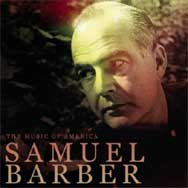
Here is the anthology of the Centennial, interspersing wonderful historical recordings (Knoxville and the Hermit Songs by Leontyne Price, the Piano Sonata by Horowitz, the Violin Concerto by Stern and Bernstein) with modern interpretations (the Symphony in One Movement by Slatkin, the Tokyo String Quartet in the world-famous String Quartet). And straight from the vaults of the Curtis Institute of Music, the proverbial cherry on the cake : a very impressive recording of Dover Beach by the 25-years-old composer in person !

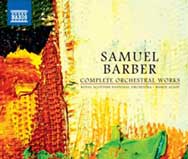
Inspired conducting, eloquent orchestra & soloists : a highly recommendable 6-CD set !

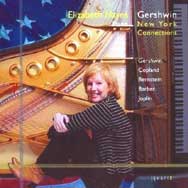
Under the title "New York Connections", this cleverly devised recital offers an overview of the 20th century American piano, firmly rooted in jazz and blues. Elizabeth Hayes delivers an energetic performance of Barber's Excursions, but is equally at ease with its more poetic (Slow Blues Tempo) or humorous tones (the final Hoe-Down). Great renditions of Joplin's ragtimes and Copland's Four Piano Blues.

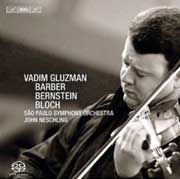
A magnificent performance of the Violin Concerto, more hedonistic than pyrotechnical. Gluzman and Neschling don't hesitate to use slow tempi, emphasizing the vocal line of the violin and orchestral writing. There's also plenty to hear and admire in Bernstein's and Bloch's works, two complements both logical and exciting to this program. [More info]

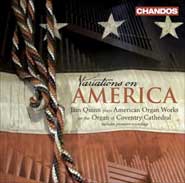
There is a gap of thirty years between the Prelude and Fugue, recorded here for the first time, and the variations on Wondrous Love. It's no surprise, then, if the quality of inspiration between the student of the Curtis Institute and the composer in full bloom reveals the same kind of gap. An interesting album, though, especially for the Variations on America by Aaron Copland.

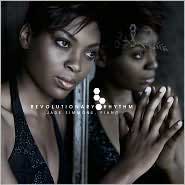
With an amazing technical mastery, the young American pianist delivers a very melodic Piano Sonata - at the risk of under-estimating its dramatic tone. It's therefore no wonder if she seems more at ease in the "playful" parts of the work - the scherzo and the final fugue - than in the initial Allegro, tense and imperious, or in the nocturnal, almost bartokian, Adagio mesto.


From Argentina to the West Indies and from Brazil... to the USA, Joel Fan invites us to a journey to the Americas. His reading of Barber's Piano Sonata conveys a striking sense of limpidity, in a beautiful and velvety sound. Rather than virtuosity, Fan displays a very hedonistic touch that underscores, surprisingly, the connection between this composition and the piano works of Debussy and Bartok.

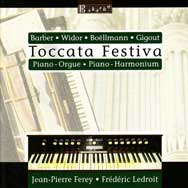

« With its two cadenzas – the second one for pedals only ! –, the Toccata Festiva has all the characteristics of an organ concerto. The organ-piano transcription recorded here put the spotlight on the organ, since the two instruments differs clearly in tone. Better than an orchestra, the virtuoso piano part gives its full meaning to the word ‘toccata’. In perfect unison, Jean-Pierre Ferey and Frédéric Ledroit find the right balance to express the festive as well as solemn nature of this enthralling composition. » Thierry Adumeau, Monde de la Musique, March 2009

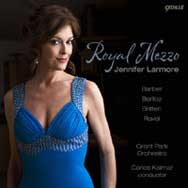
A most expressionist version of this concert aria which gives a taste of the aesthetic atmosphere of Antony and Cleopatra. With a timber as compelling as ever, Jennifer Larmore enacts a woman, at times rebellious, loving, furious, resigned… Barber’s music has rarely offered such a variety of climates and orchestral colors. An excellent modern recording of this work, that equals in intensity the Roberta Alexander performance (CD Etcetera).

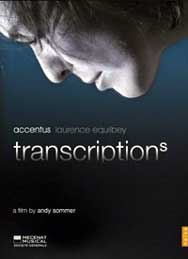
Since both albums Transcriptions and Transcriptions 2, featuring a rare choir repertoire by Accentus and Laurence Equilbey, had met with public acclaim, Andy Sommer’s mission was to put these interpretations in pictures. The Adagio for Strings, in its choir setting Agnus Dei, remains as captivating as ever. One might be slightly less enthusiastic about the video clip showing the Accentus singers marching through an all-concrete parking lot bathed in blue, yellow and green neon lights…

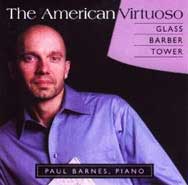
A rather strange title (« The American Virtuoso ») for this recital featuring Nocturne and Ballade, two compositions in which Barber pays a not so virtuoso homage to Chopin and Schumann. Paul Barnes does not sound as comfortable in these works as he does with the Sonata, in his interpretation full of energy and musicality. One may regret the lingering impression that the piano was placed in a water tank rather than a recording studio.

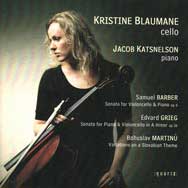
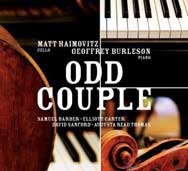
The Cello Sonata was written during Barber’s training years at the Curtis Institute of Music in Philadelphia and exudes the love the young composer felt for Brahms’s music. The future development of Barber’s musical style is almost palpable in the Blaumane/Katsnelson recording, with its strong sense of drama, its long melodic lines and their declamatory style. The « Odd Couple » Matt Haimovitz and Geoffrey Burleson give a somewhat dry interpretation of a piece where sudden changes in rhythm seem to compensate for an otherwise flat musical line..



The Cello Sonata was written during Barber’s training years at the Curtis Institute of Music in Philadelphia and exudes the love the young composer felt for Brahms’s music. The future development of Barber’s musical style is almost palpable in the Blaumane/Katsnelson recording, with its strong sense of drama, its long melodic lines and their declamatory style. The « Odd Couple » Matt Haimovitz and Geoffrey Burleson give a somewhat dry interpretation of a piece where sudden changes in rhythm seem to compensate for an otherwise flat musical line.

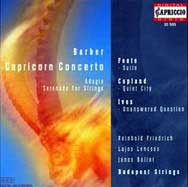
Of the three pieces featured in the program, the Capricorn Concerto is certainly worth a good listening – as much as the very naive CD cover is worth a good laugh ! Not as light-hearted as it may initially sound, this composition reminiscent of the concerto grosso genre pays tribute to the “neo-classical Axis” Bach-Stravinsky-Martinu. The trio, particularly the oboe-player, Lajos Lencsés, gives an ideally vivid and playful interpretation.

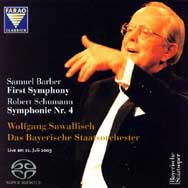
« An outstanding performance of the First Symphony . This wonderful work composed in 1936 by the 26 year-old Samuel Barber strikes by its ambitious and fully-fledged dimension, with its one-movement structure integrating the traditional four movements. One can easily imagine that Schoenberg could have written the piece, had he not taken the atonal-dodecaphonic path. » Philippe van den Bosch, ConcertoNet (complete review - in French )
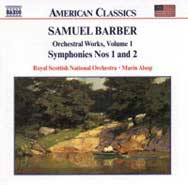
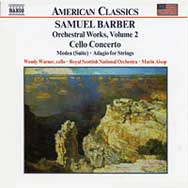
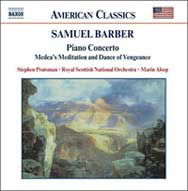
Complete Works for Orchestra In six volumes :Symphonies No. 1-2, Essays No. 1-3, Violin Concerto, Piano Concerto, Cello Concerto, Capricorn Concerto, Medea's Meditation and Dance of Vengeance, Medea (Suite), Die Natali, Knoxville Summer of 1915, Music for a Scene from Shelley, Mutations from Bach, A Hand of Bridge, Commando March, Fadograph of a Yestern Scene, Canzonetta, Serenade, Souvenirs, Intermezzo of Vanessa, Overture « The School for Scandal »
Royal Scottish National Orchestra, Marin AlsopNaxos / 8.559024, 8.559044, 8.559088, 8.559133, 8.559134, 8.559135
The budget-label Naxos strikes hard with the release of Barber’s complete works for orchestra under the baton of Marin Alsop, one of the most talented conductors of the young generation. Leading the Royal Scottish National Orchestra, she instills eloquence, instinct and energy into each of these performances. The six volumes are, overall, of excellent quality, especially the Piano and Cello Concertos (with Stephen Prutsman and Wendy Warner), the Medea ballet and Knoxville Summer of 1915 (with Karina Gauvin). The two symphonies are both outstanding – the second being a personal favorite of Marin Alsop. Fans of Barber should add to their Naxos collection the complete works for choir (Ormond College Choir).




Complete Works for Orchestra In six volumes :Symphonies No. 1-2, Essays No. 1-3, Violin Concerto, Piano Concerto, Cello Concerto, Capricorn Concerto, Medea's Meditation and Dance of Vengeance, Medea (Suite), Die Natali, Knoxville Summer of 1915, Music for a Scene from Shelley, Mutations from Bach, A Hand of Bridge, Commando March, Fadograph of a Yestern Scene, Canzonetta, Serenade, Souvenirs, Intermezzo of Vanessa, Overture « The School for Scandal »
Royal Scottish National Orchestra, Marin AlsopNaxos / 8.559024, 8.559044, 8.559088, 8.559133, 8.559134, 8.559135
The budget-label Naxos strikes hard with the release of Barber’s complete works for orchestra under the baton of Marin Alsop, one of the most talented conductors of the young generation. Leading the Royal Scottish National Orchestra, she instills eloquence, instinct and energy into each of these performances. The six volumes are, overall, of excellent quality, especially the Piano and Cello Concertos (with Stephen Prutsman and Wendy Warner), the Medea ballet and Knoxville Summer of 1915 (with Karina Gauvin). The two symphonies are both outstanding – the second being a personal favorite of Marin Alsop. Fans of Barber should add to their Naxos collection the complete works for choir (Ormond College Choir).

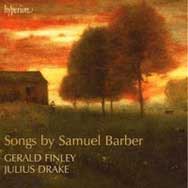
The Canadian baritone Gerald Finley discovered Barber's music through Thomas Allen's recording of Dover Beach. This selection of Barber's songs is just as astounding. Finley delivers a very fine performance of the Mélodies Passagères, based on French poems by Rilke and dedicated to Francis Poulenc. The rest of the program is equally inspired, and earned this CD the Gramophone Award 2008 for the best solo vocal recording.

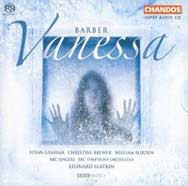
Recorded during the triumphant series of performances at the Barbican Center of London in 2003, this Vanessa is an absolute modern reference. Susan Graham is a breathtakingly natural Erika, while Catherine Wyn-Rogers sounds cut to enact the Baroness. In the leading role, Christine Brewer is no smaller Vanessa than Eleanor Steber was. Slatkin manages to instill big-scale drama into this “chamber drama” (shortened from 4 to 3 acts) and the orchestra plays with vivid richness. A desert island disc.

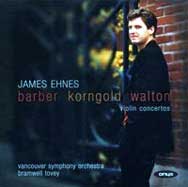
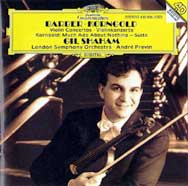
The Violin Concerto is probably Barber’s most popular work for orchestra, together with the Adagio. At the turn of the 21st century, a number of great virtuosos gave wonderful interpretations of the Concerto : Itzhak Perlman (EMI), Hilary Hahn (Sony), Anne Akiko Meyers (RCA), Joshua Bell (Decca). In quite a miraculous way, the 31 year-old James Ehnes and 22 year-old Gil Shaham somehow managed to oust those prestigious versions. The two musicians have so many qualities in common that they are impossible to tell apart : complete technical mastery serving maximum expressivity as well as astounding mastery of all registers (drama, humor, playfulness and nostalgia.), a sumptuous sound and permanent complicity with a totally committed orchestra. The same qualities appear in their respective rendition of the Korngold Concerto. The Walton is an extraordinary fill-up in Ehnes’ album.



The Violin Concerto is probably Barber’s most popular work for orchestra, together with the Adagio. At the turn of the 21st century, a number of great virtuosos gave wonderful interpretations of the Concerto : Itzhak Perlman (EMI), Hilary Hahn (Sony), Anne Akiko Meyers (RCA), Joshua Bell (Decca). In quite a miraculous way, the 31 year-old James Ehnes and 22 year-old Gil Shaham somehow managed to oust those prestigious versions. The two musicians have so many qualities in common that they are impossible to tell apart : complete technical mastery serving maximum expressivity as well as astounding mastery of all registers (drama, humor, playfulness and nostalgia.), a sumptuous sound and permanent complicity with a totally committed orchestra. The same qualities appear in their respective rendition of the Korngold Concerto. The Walton is an extraordinary fill-up in Ehnes’ album.

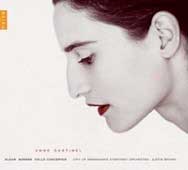
French musicians seem still quite reluctant to venture into the American repertoire. Hence the surprise with this brilliant interpretation of Barber’s Cello Concerto by Anne Gastinel. No heated argument in her dialogue with the orchestra, but a genuinely passionate conversation that’s full of clarity. The cellist unfolds the Andante, the emotional heart of this masterwork, with a noble, desolate and poignant bow.

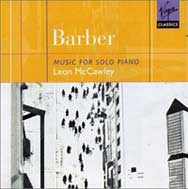
Released in 1997, this recording by a 24 year-old British pianist is much more than a “debut album”. It is simply the best contemporary anthology of Barber’s piano works. McCawley skims above the technical difficulty of the Sonata, plays the Excursions and Souvenirs with panache and humor, throws himself in the three miniatures of the program with an exquisite sense of poetry. A revelation that already sounds like a consecration.

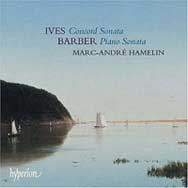
While always under control, Hamelin’s interpretation, stirring and crystal-clear, transcends the Piano Sonata to make a monument of harmony, strength and euphoria out of it. The Concord Sonata of Charles Ives is a provocative addition to this album : Barber hated Ives’ music !

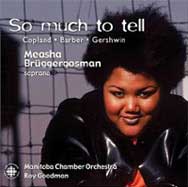
Before becoming the rising star of Deutsche Grammophon, Measha Brueggergosman recorded this all-American program at the beginning of her career. Both the quality of the chamber orchestra and the talent of the Canadian soprano as a story-teller give that little bit of extra something that makes the cozy atmosphere of this album a highly enjoyable experience.

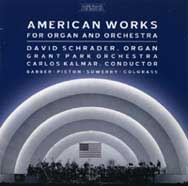
Composed in 1960 especially for the brand new Aeolian-Skinner organ of the Curtis Institute of Music, the Toccata Festiva is a one-movement organ concerto in disguise. David Schrader and Carlos Kalmar sign a wonderful interpretation, both sparkling and dramatic. The recording mirrors the spot-on organ/orchestra balance. Fifteen minutes of musical bliss.

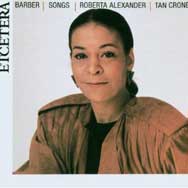
Published in 1995, this almost complete recording of Barber's song-cycles (the Mélodies passagères and the 3 Songs op.45 are missing) featured the world-premiere of Despite and Still. Roberta Alexander's performance impresses by its technical mastery and extreme versatility : the singer is equally at ease with the intimistic art songs of the op.13 and with more dramatic songs such as I Hear an Army, Nuvoletta or the always surprising Hermit Songs.
Since their first performances, works of contemporaries of Barber such as Benjamin Britten, Aaron Copland and Leonard Bernstein have never ceased to be recorded. Similarly, the music of Samuel Barber has regularly been recorded since the 30’s, and championed by what can now be identified as three generations of musicians :
The Founders often premiered the works and represent, nowadays, the original spirit of Barber’s music. Their interpretations are priceless historical testimonies;
The Heirs were at the outset of their career when Barber reached his last few years. Some of them even had the occasion to discuss Barber’s music with the composer himself;
Today, the Young Generation is the third generation of interpreters, with their own stimulating and inventive approach to Barber’s music. Thanks to their enthusiasm, Barber’s works are still regularly recorded in studios and performed in concert halls all over the world.
The three lists below will be updated as new recordings are released.